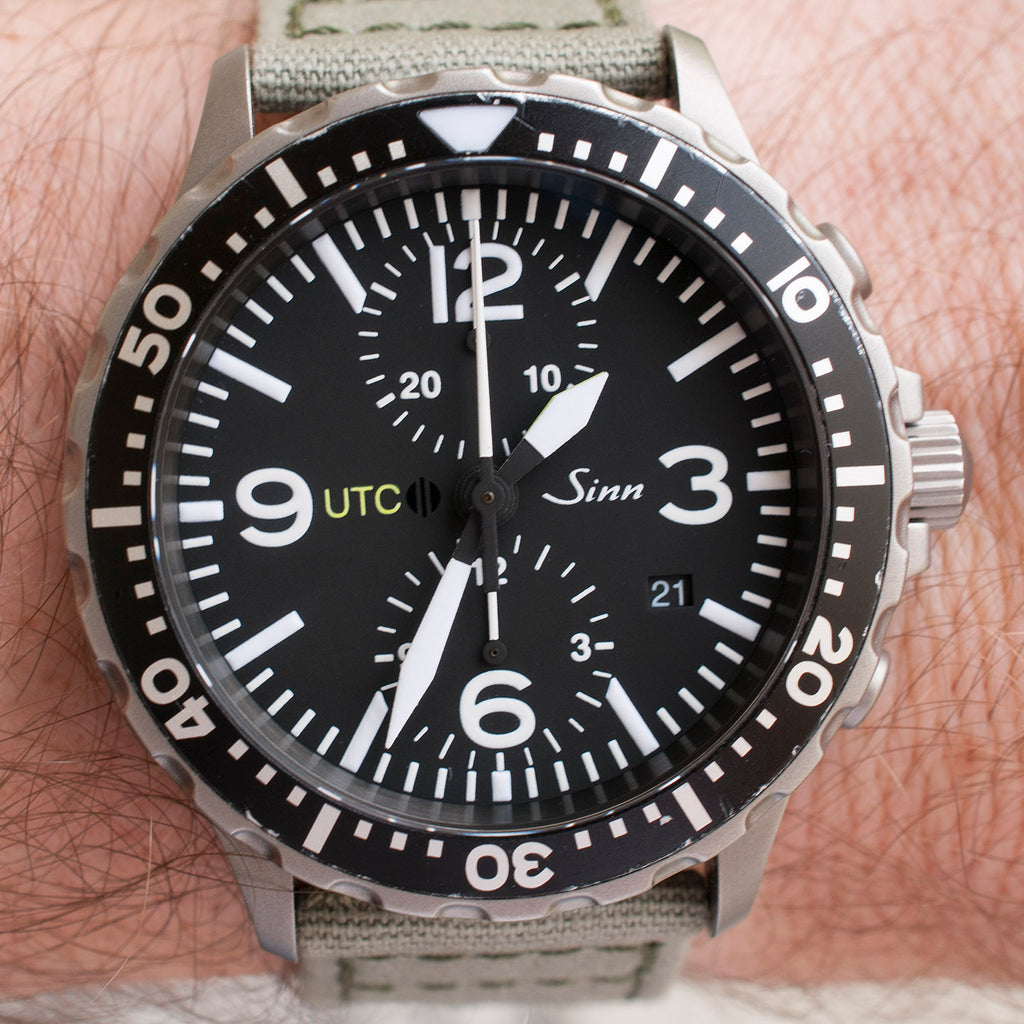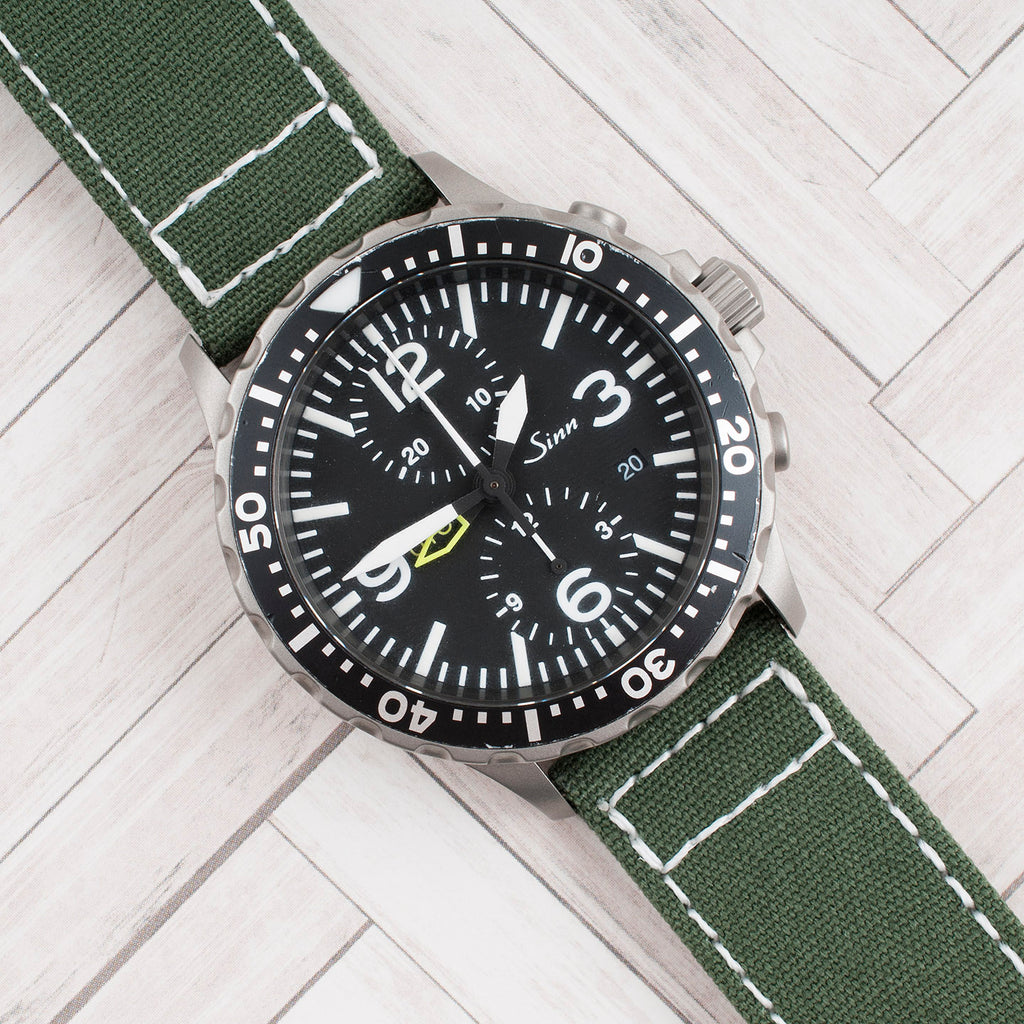
Sinn 757 UTC Watch Review - Why Did Sinn Discontinue This?
Nick Lehner
When I write these reviews, the first paragraph is usually spent giving a background story of why I purchased, borrowed, or otherwise obtained the subject watch of the review. In the case of this Sinn 757 UTC, I simply borrowed it from my friend because two of my watches are in for service, and I needed a few watches to use for strap photos.
But that doesn't mean that I wasn't excited to wear it! Regular readers of the StrapHabit blog are aware that I'm a big fan of Sinn's dive watches. I've covered all of the U variants that I have been able to get my hands on, and even decided that my U1S is the best dive watch available. I always enjoy seeing my friend wearing the 757, so I was glad to get my hands on it for a longer period of time.
Many of Sinn's watches are designed to be used as a tool in a specific scenario. While the 757 UTC is simply described by Sinn as "The Duochronograph with captive bezel" (how German is that?) it is intended to be used by pilots. Watch collectors typically envision a WW2 A- or B-Uhr dial when thinking of a pilot watch, but the 757 UTC has features that are useful and durable for modern pilots and the difficult conditions that one might encounter in a cockpit.
Unfortunately, when looking up the 757's specs for this article, I discovered that Sinn had discontinued it. It does make models with similar functionality, such as the 103 and the non-chronograph version called the 857, but none of them have the same combination of good looks and useful features as the 757 UTC. Was there another reason that Sinn decided to stop making it?
Packed with Sinn's Tech
While the now-discontinued 757 UTC might not have the abysmal water-resistance of the 1000m-capable U1, it does have a laundry list of Sinn's technology and features applied. These are all things that will be useful to more people than the ability to go to depths that would literally kill you (plus the 757 still has a very sufficient 200m rating).

The most obvious upgrades can be seen on the dial. The "base" 757 has a two-register chronograph complication. Upgrading to the UTC model added not only three yellow letters to the dial, but also a hidden party piece. A yellow, skeletonized hour hand can be deployed from behind the main white hour hand of the same shape to indicate a second time zone on the 12-hour scale. Turn the crown away from you, and the date advances. Turn it towards you, and the yellow hand advances by one hour.

While it's not a "true" or "traveler's" GMT, it provides a simple and effective way of showing the time in another location (if you'd like to learn more about the benefits of each type of GMT, check out this article that I wrote for ABTW last year). It's perfect for someone who calls or occasionally travels to other time zones on the same side of the globe but doesn't need the distraction of a full GMT hand most of the time.
The 757 UTC also uses Sinn's Ar-Dehumidifying Technology which is designed to preserve the oils on the movement, and also prevent fogging of the crystal in extreme temperature changes. Sinn achieves this through three elements: EDR seals, filling the case with inert argon gas, and a dehumidifying capsule that can be seen embedded in one of the lugs of the 757 UTC.
You can see from the light blue color that this watch has not experienced a significant level of humidity inside the case. Dark blue indicates that it is time to replace the capsule (and likely also service the movement).

The watch is also rated to operate reliably at extreme temperatures (-45 to +80 deg C, or -49 to +176 deg F). Sinn achieves this through the use of special oils, followed by a test of every watch in a temperature chamber.
Continuing the list of torture tests that it can withstand, the 757 UTC is also rated to run accurately in the presence of magnetic fields. Through the use of a soft iron cage comprising the dial, movement holding ring, and an iron plate behind the nickel-free caseback, Sinn rates its anti-magnetic watches as being able to withstand 80,000 A/m (or 1000 gauss for those fans of the Rolex engineer watch) and indicates this with a subtle black logo on the dial next to the UTC text. For more on what an anti-magnetic watch might mean to you, read this other article that I wrote for ABTW last year.

Like the U1S, it also has a captive bezel secured by screws, is resistant to low pressure, has a tegimented (hardened steel) case and a similarly excellent treatment of Sinn's anti-reflective coating on both sides of its crystal.

Wearing the 757 UTC
I've owned or borrowed a number of Sinn watches, and all of them have worn very well. A lot of this is achieved through the lug design, and the 757 is no exception. Despite its large 43mm diameter and 15mm thickness, the short and low-mounted lugs mean that it sits well on the wrist, and doesn't feel too long, or top-heavy.


Another thing that Sinn gets right on most of its watches (aside from the U1 Camouflage) is legibility. The standard U1 is still the champ, but for a watch that displays as much information as the 757 UTC does, it is surprisingly easy to read the time. The chronograph hands are all thin white sticks, and the subdials are the same matte black as the dial, and are borderless and not recessed. The important markings are large, and the ones that are used less often are small and subtle. Sinn even omitted the running seconds subdial to further clean up the display.

Minimal text is used, and as mentioned, the UTC hand can be hidden when not needed (although it being skeletonized and a contrasting color also makes it easy to differentiate).
I also usually like Sinn's application of date windows. This is usually tricky to get right on a busy chronograph. Despite a 4 o'clock date window being a point of contention among watch hobbyists, I think it's the best spot for it on the 757. It's easy to read but hides visually when not needed, plus Sinn went to the trouble of installing a custom date disc with the numerals oriented correctly.

The legibility is also good in the dark. Like the U1, the lume is not the brightest, but it is long-lasting, and the large applications of it make it easy to read even as it dims. Interestingly, only the large 12 numeral is lumed. I would prefer all of them for consistency, but this does make it easy to orient the dial visually when reading at a glance.

The 60-click bezel has a very similar precise, yet chunky feel to the U1, but since this is not a dive bezel, it is bi-directional. It is easy to grip, as are the crown and chronograph pushers. My only complaint about operating the 757 UTC is that I had trouble remembering which way to turn the crown to advance the UTC hand, and accidentally changed the date a few times.

This watch has been well-used as you can see from the minor dings on the aluminum bezel insert. Despite that, there are no signs of scratches on the case and only a few minor dings. This goes to show the effectiveness of Sinn's tegiment hardening process to the steel case.
Straps and Bracelet
The 757 was available from Sinn with a variety of leather or silicone straps, and Sinn's stainless steel bracelet. Unfortunately, my friend bought this watch used, and I didn't have any Sinn straps or bracelets to review. According to the Sinn website, U1 and 757 straps are compatible. Thus, you can read this review to learn my impressions of some of the OE straps options for this watch.
Of course, it was fitted to a number of StrapHabit straps for the review. As you can see, the 757 is a strap monster that looks good on almost anything. The owner of the watch normally wears it on the well-used Black and Gray Bond Elastic Strap shown below.

Movement
The 757 UTC uses a modified Valjoux 7750. The day of the week display is removed to allow for the second jumping 12-hour hand mechanism, the running seconds subdial is removed, and the movement also uses Sinn's special oils as mentioned above. It's the perfect movement for a tool chronograph like the 757 UTC.

Conclusion
There is a lot to like about the Sinn 757 UTC. Sinn has loaded this watch up with features and technology that not only make it extremely useful but also robust in any situation that it might encounter. In addition, it has the thoughtful design that fans of the Sinn brand have come to expect. This makes it very comfortable to wear, and also legible.

In this section, I also often talk about the value or bang for the buck of the watch in question. Because the 757 UTC was discontinued a number of years ago, I tried to find the value of used ones, but none showed up on WatchRecon, eBay, or Chrono24, and WatchCharts doesn't list a value for it.
Did it not sell well, and that is why Sinn discontinued it? Or maybe current owners know what they have and don't want to sell. Either way, I really enjoyed wearing it. Hopefully, Sinn will bring back a limited edition reissue of it, as it has been doing with some of its other legacy models recently.
Your Thoughts
Do you have a favorite tool chronograph watch? Let us know what it is in the comments.

Specifications:
Name: Sinn 757 UTC
Reference Number: 757.011
Price: Discontinued
Dimensions: 43mm diameter, 49mm lug-to-lug, 15mm thick
Lug Width: 22mm
Movement: Valjoux 7750 GMT
Water Resistance: 200m
Weight: 111g (head only)
Crystal: Sapphire with clear AR coating on both sides
Crown: Screw-down
Bezel: Bidirectional, tegimented steel 60 clicks
Strap/Bracelet: It was available with a number of leather or silicone straps or a stainless steel bracelet (standard strap was not available, StrapHabit straps shown for the review).





